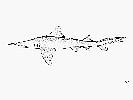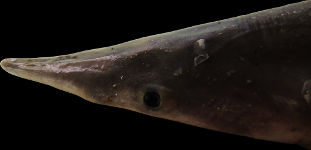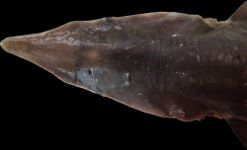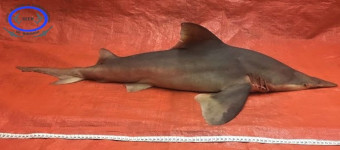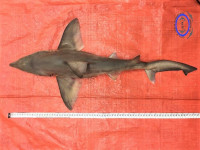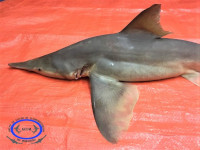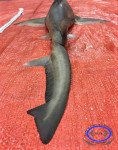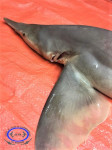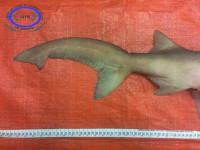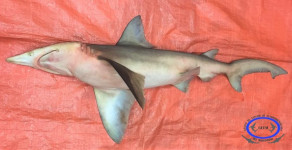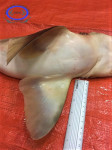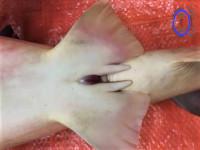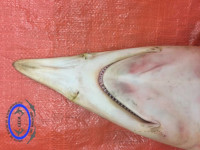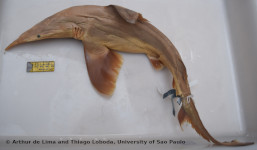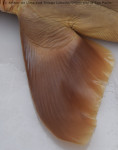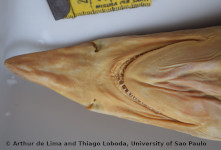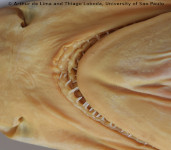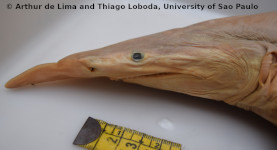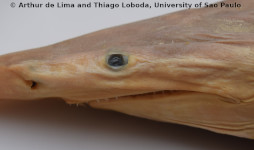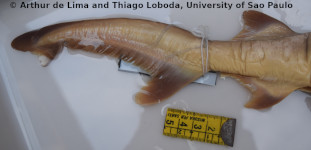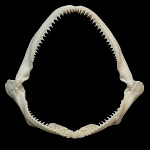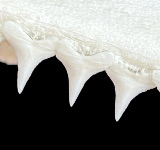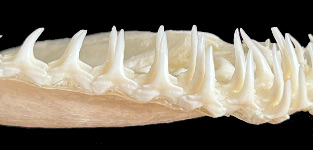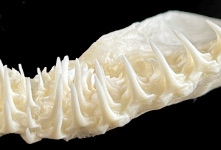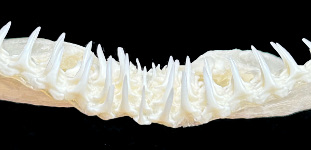Carcharhinus oxyrhynchus
(Müller & Henle, 1839)
Daggernose shark
Classification: Elasmobranchii Carcharhiniformes Carcharhinidae
Reference of the original description
Systematische Beschreibung der Plagiostomen. Berlin, Veit, pp. 1–200
Systematische Beschreibung der Plagiostomen. Berlin, Veit, pp. 1–200
Image of the original description
.jpg)
Carcharhinus oxyrhynchus (Müller & Henle, 1838)
.jpg)
Carcharhinus oxyrhynchus (Müller & Henle, 1838)
Synonyms / new combinations and misspellings
Carcharhinus oxyrhinchus, Carcharias oxyrhynchus, Carcharias (Prionodon) oxyrhynchus, Carcharinus oxyrhynchus, Eulamia oxyrhynchus, Isogomphodon oxyrhynchus, Squalus (Carcharinus) oxyrhynchus
Carcharhinus oxyrhinchus, Carcharias oxyrhynchus, Carcharias (Prionodon) oxyrhynchus, Carcharinus oxyrhynchus, Eulamia oxyrhynchus, Isogomphodon oxyrhynchus, Squalus (Carcharinus) oxyrhynchus
Types
Carcharhinus oxyrhynchus
Isogomphodon oxyrhynchus
Syntype: MNHN: A-9664 Cayenne RMNH: 4297 Suriname ZMB: 4539
Carcharhinus oxyrhynchus
Isogomphodon oxyrhynchus
Syntype: MNHN: A-9664 Cayenne RMNH: 4297 Suriname ZMB: 4539
Description :
Citation: Carcharhinus oxyrhynchus (Müller & Henle, 1839): In: Database of modern sharks, rays and chimaeras, www.shark-references.com, World Wide Web electronic publication, Version 01/2026
Please send your images of "Carcharhinus oxyrhynchus" to info@shark-references.com

Carcharhinus oxyrhynchus (Müller & Henle, 1839), young-of-the-year male © Ana Paula Chaves and Jorge Nunes

Carcharhinus oxyrhynchus (Müller & Henle, 1839), young-of-the-year male © Ana Paula Chaves and Jorge Nunes
Common names
 Cazón picudo,
Cazón picudo,  Cazón picudo sudamericano,
Cazón picudo sudamericano,  Requin bécune,
Requin bécune,  Daggernose shark,
Daggernose shark,  Cação bicudo
Cação bicudo
 Cazón picudo,
Cazón picudo,  Cazón picudo sudamericano,
Cazón picudo sudamericano,  Requin bécune,
Requin bécune,  Daggernose shark,
Daggernose shark,  Cação bicudo
Cação bicudo
Short Description
Original diagnosis after Compagno, 1984 [517]:
Field Marks: An unmistakable requiem shark, with an extremely long, flattened, acutely pointed, triangular snout, minute circular eyes with nictitating eyelids, very large, paddle-shaped pectoral fins, the first dorsal fin with its origin over the pectoral fins, narrow, erectcusped small teeth, without cusplets, in both jaws, upper teeth serrated, and over 45 rows of teeth in both jaws, and colour grey or yellow-grey above and white below, without prominent markings. This shark bears a superficial resemblance to rhinochimaerids, the goblin shark (Mitsukurina) and certain undescribed species of the scyliorhinid genus Apristurus, all of which have similar long snouts.
Diagnostic Features : Body fairly stout. Head narrow and flattened but not trowel-shaped; snout acutely triangular or subtriangular in dorsoventral view and very long, with preoral length much greater than internarial space and mouth width; eyes extremely small, without posterior notches; spiracles absent; no papillose gillrakers on internal gill openings; nostrils small, internarial space about 3 times the nostril width; anterior nasal flaps vestigial, not tubular; labial furrows short but prominent, essentially confined to mouth corners, with uppers about equal to lowers and with their anterior ends falling far behind eyes; teeth not strongly differentiated in upper and lower jaws, anteroposteriors with more or less erect, narrow acute cusps, no cusplets, and proximal and distal blades; uppers with slightly broader flatter cusps and serrations; lowers with slenderer cusps and smooth edges; cusps of lower teeth not protruding when mouth is closed; 49 to 60/49 to 56 rows of teeth. Interdorsal ridge absent; no lateral keels on caudal peduncle; upper precaudal pit transverse and crescentic. First dorsal origin far forward, over midbase or second third of pectoral bases, its midbase much closer to pectoral bases than to pelvics and free rear tip well anterior to pelvic fin origins; second dorsal fin considerably smaller than first but rather large, its height about 1/2 of first dorsal height, its origin slightly anterior or opposite anal origin; pectoral fins broad and triangular, their lengths from origin to free rear tip about 3/4 of pectoral anterior margins; pectoral origins about under 5th gill slit; anal fin somewhat smaller than second dorsal, with preanal ridges very short and a deeply notched posterior margin. Colour grey or brownish above, without a colour pattern. Moderatesized sharks, adults probably not exceeding 1.6 m.
Original diagnosis after Compagno, 1984 [517]:
Field Marks: An unmistakable requiem shark, with an extremely long, flattened, acutely pointed, triangular snout, minute circular eyes with nictitating eyelids, very large, paddle-shaped pectoral fins, the first dorsal fin with its origin over the pectoral fins, narrow, erectcusped small teeth, without cusplets, in both jaws, upper teeth serrated, and over 45 rows of teeth in both jaws, and colour grey or yellow-grey above and white below, without prominent markings. This shark bears a superficial resemblance to rhinochimaerids, the goblin shark (Mitsukurina) and certain undescribed species of the scyliorhinid genus Apristurus, all of which have similar long snouts.
Diagnostic Features : Body fairly stout. Head narrow and flattened but not trowel-shaped; snout acutely triangular or subtriangular in dorsoventral view and very long, with preoral length much greater than internarial space and mouth width; eyes extremely small, without posterior notches; spiracles absent; no papillose gillrakers on internal gill openings; nostrils small, internarial space about 3 times the nostril width; anterior nasal flaps vestigial, not tubular; labial furrows short but prominent, essentially confined to mouth corners, with uppers about equal to lowers and with their anterior ends falling far behind eyes; teeth not strongly differentiated in upper and lower jaws, anteroposteriors with more or less erect, narrow acute cusps, no cusplets, and proximal and distal blades; uppers with slightly broader flatter cusps and serrations; lowers with slenderer cusps and smooth edges; cusps of lower teeth not protruding when mouth is closed; 49 to 60/49 to 56 rows of teeth. Interdorsal ridge absent; no lateral keels on caudal peduncle; upper precaudal pit transverse and crescentic. First dorsal origin far forward, over midbase or second third of pectoral bases, its midbase much closer to pectoral bases than to pelvics and free rear tip well anterior to pelvic fin origins; second dorsal fin considerably smaller than first but rather large, its height about 1/2 of first dorsal height, its origin slightly anterior or opposite anal origin; pectoral fins broad and triangular, their lengths from origin to free rear tip about 3/4 of pectoral anterior margins; pectoral origins about under 5th gill slit; anal fin somewhat smaller than second dorsal, with preanal ridges very short and a deeply notched posterior margin. Colour grey or brownish above, without a colour pattern. Moderatesized sharks, adults probably not exceeding 1.6 m.
Distribution
Western Atlantic: Trinidad, Guyana, Suriname, French Guiana, and Brazil.
Western Atlantic: Trinidad, Guyana, Suriname, French Guiana, and Brazil.
Human uses
fisheries: subsistence fisheries
fisheries: subsistence fisheries
Biology
Distinct pairing with embrace [17086]. Viviparous, placental [733]. An inshore shark found over rocky bottoms, entering estuaries and river mouths. Feeds on small schooling fishes including herring, anchovies and croakers.
Distinct pairing with embrace [17086]. Viviparous, placental [733]. An inshore shark found over rocky bottoms, entering estuaries and river mouths. Feeds on small schooling fishes including herring, anchovies and croakers.
Remarks
shark-references Species-ID=807; taxonomic note: da Silva Rodrigues-Filho et al. (2023) [31681]: "Isogomphodon oxyrhynchus and Prionace glauca are therefore reclassified and recognized as Carcharhinus oxyrhynchus and Carcharhinus glaucus."
shark-references Species-ID=807; taxonomic note: da Silva Rodrigues-Filho et al. (2023) [31681]: "Isogomphodon oxyrhynchus and Prionace glauca are therefore reclassified and recognized as Carcharhinus oxyrhynchus and Carcharhinus glaucus."








